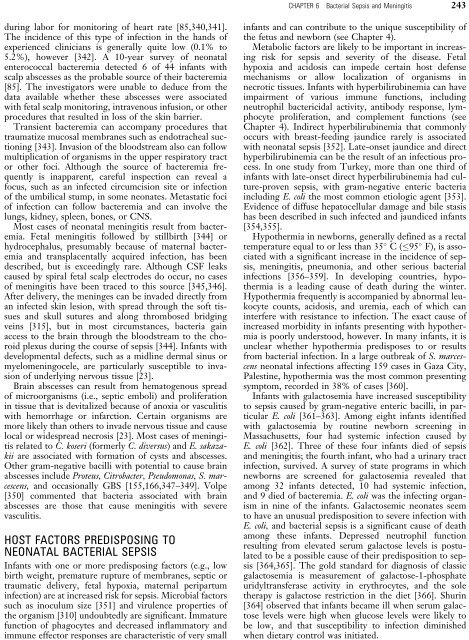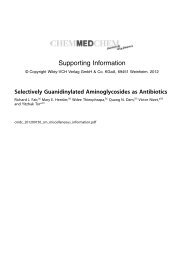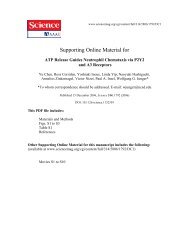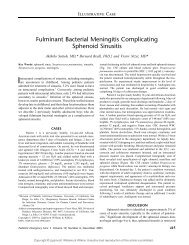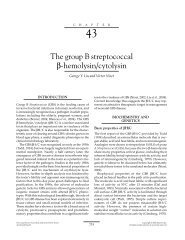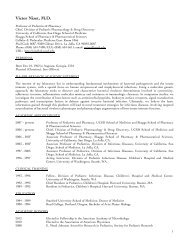BACTERIAL SEPSIS AND MENINGITIS - Nizet Laboratory at UCSD
BACTERIAL SEPSIS AND MENINGITIS - Nizet Laboratory at UCSD
BACTERIAL SEPSIS AND MENINGITIS - Nizet Laboratory at UCSD
You also want an ePaper? Increase the reach of your titles
YUMPU automatically turns print PDFs into web optimized ePapers that Google loves.
during labor for monitoring of heart r<strong>at</strong>e [85,340,341].<br />
The incidence of this type of infection in the hands of<br />
experienced clinicians is generally quite low (0.1% to<br />
5.2%), however [342]. A 10-year survey of neon<strong>at</strong>al<br />
enterococcal bacteremia detected 6 of 44 infants with<br />
scalp abscesses as the probable source of their bacteremia<br />
[85]. The investig<strong>at</strong>ors were unable to deduce from the<br />
d<strong>at</strong>a available whether these abscesses were associ<strong>at</strong>ed<br />
with fetal scalp monitoring, intravenous infusion, or other<br />
procedures th<strong>at</strong> resulted in loss of the skin barrier.<br />
Transient bacteremia can accompany procedures th<strong>at</strong><br />
traum<strong>at</strong>ize mucosal membranes such as endotracheal suctioning<br />
[343]. Invasion of the bloodstream also can follow<br />
multiplic<strong>at</strong>ion of organisms in the upper respir<strong>at</strong>ory tract<br />
or other foci. Although the source of bacteremia frequently<br />
is inapparent, careful inspection can reveal a<br />
focus, such as an infected circumcision site or infection<br />
of the umbilical stump, in some neon<strong>at</strong>es. Metast<strong>at</strong>ic foci<br />
of infection can follow bacteremia and can involve the<br />
lungs, kidney, spleen, bones, or CNS.<br />
Most cases of neon<strong>at</strong>al meningitis result from bacteremia.<br />
Fetal meningitis followed by stillbirth [344] or<br />
hydrocephalus, presumably because of m<strong>at</strong>ernal bacteremia<br />
and transplacentally acquired infection, has been<br />
described, but is exceedingly rare. Although CSF leaks<br />
caused by spiral fetal scalp electrodes do occur, no cases<br />
of meningitis have been traced to this source [345,346].<br />
After delivery, the meninges can be invaded directly from<br />
an infected skin lesion, with spread through the soft tissues<br />
and skull sutures and along thrombosed bridging<br />
veins [315], but in most circumstances, bacteria gain<br />
access to the brain through the bloodstream to the choroid<br />
plexus during the course of sepsis [344]. Infants with<br />
developmental defects, such as a midline dermal sinus or<br />
myelomeningocele, are particularly susceptible to invasion<br />
of underlying nervous tissue [23].<br />
Brain abscesses can result from hem<strong>at</strong>ogenous spread<br />
of microorganisms (i.e., septic emboli) and prolifer<strong>at</strong>ion<br />
in tissue th<strong>at</strong> is devitalized because of anoxia or vasculitis<br />
with hemorrhage or infarction. Certain organisms are<br />
more likely than others to invade nervous tissue and cause<br />
local or widespread necrosis [23]. Most cases of meningitis<br />
rel<strong>at</strong>ed to C. koseri (formerly C. diversus) and E. sakazakii<br />
are associ<strong>at</strong>ed with form<strong>at</strong>ion of cysts and abscesses.<br />
Other gram-neg<strong>at</strong>ive bacilli with potential to cause brain<br />
abscesses include Proteus, Citrobacter, Pseudomonas, S. marcescens,<br />
and occasionally GBS [155,166,347–349]. Volpe<br />
[350] commented th<strong>at</strong> bacteria associ<strong>at</strong>ed with brain<br />
abscesses are those th<strong>at</strong> cause meningitis with severe<br />
vasculitis.<br />
HOST FACTORS PREDISPOSING TO<br />
NEONATAL <strong>BACTERIAL</strong> <strong>SEPSIS</strong><br />
Infants with one or more predisposing factors (e.g., low<br />
birth weight, prem<strong>at</strong>ure rupture of membranes, septic or<br />
traum<strong>at</strong>ic delivery, fetal hypoxia, m<strong>at</strong>ernal peripartum<br />
infection) are <strong>at</strong> increased risk for sepsis. Microbial factors<br />
such as inoculum size [351] and virulence properties of<br />
the organism [310] undoubtedly are significant. Imm<strong>at</strong>ure<br />
function of phagocytes and decreased inflamm<strong>at</strong>ory and<br />
immune effector responses are characteristic of very small<br />
CHAPTER 6 Bacterial Sepsis and Meningitis<br />
243<br />
infants and can contribute to the unique susceptibility of<br />
the fetus and newborn (see Chapter 4).<br />
Metabolic factors are likely to be important in increasing<br />
risk for sepsis and severity of the disease. Fetal<br />
hypoxia and acidosis can impede certain host defense<br />
mechanisms or allow localiz<strong>at</strong>ion of organisms in<br />
necrotic tissues. Infants with hyperbilirubinemia can have<br />
impairment of various immune functions, including<br />
neutrophil bactericidal activity, antibody response, lymphocyte<br />
prolifer<strong>at</strong>ion, and complement functions (see<br />
Chapter 4). Indirect hyperbilirubinemia th<strong>at</strong> commonly<br />
occurs with breast-feeding jaundice rarely is associ<strong>at</strong>ed<br />
with neon<strong>at</strong>al sepsis [352]. L<strong>at</strong>e-onset jaundice and direct<br />
hyperbilirubinemia can be the result of an infectious process.<br />
In one study from Turkey, more than one third of<br />
infants with l<strong>at</strong>e-onset direct hyperbilirubinemia had culture-proven<br />
sepsis, with gram-neg<strong>at</strong>ive enteric bacteria<br />
including E. coli the most common etiologic agent [353].<br />
Evidence of diffuse hep<strong>at</strong>ocellular damage and bile stasis<br />
has been described in such infected and jaundiced infants<br />
[354,355].<br />
Hypothermia in newborns, generally defined as a rectal<br />
temper<strong>at</strong>ure equal to or less than 35 C( 95 F), is associ<strong>at</strong>ed<br />
with a significant increase in the incidence of sepsis,<br />
meningitis, pneumonia, and other serious bacterial<br />
infections [356–359]. In developing countries, hypothermia<br />
is a leading cause of de<strong>at</strong>h during the winter.<br />
Hypothermia frequently is accompanied by abnormal leukocyte<br />
counts, acidosis, and uremia, each of which can<br />
interfere with resistance to infection. The exact cause of<br />
increased morbidity in infants presenting with hypothermia<br />
is poorly understood, however. In many infants, it is<br />
unclear whether hypothermia predisposes to or results<br />
from bacterial infection. In a large outbreak of S. marcescens<br />
neon<strong>at</strong>al infections affecting 159 cases in Gaza City,<br />
Palestine, hypothermia was the most common presenting<br />
symptom, recorded in 38% of cases [360].<br />
Infants with galactosemia have increased susceptibility<br />
to sepsis caused by gram-neg<strong>at</strong>ive enteric bacilli, in particular<br />
E. coli [361–363]. Among eight infants identified<br />
with galactosemia by routine newborn screening in<br />
Massachusetts, four had systemic infection caused by<br />
E. coli [362]. Three of these four infants died of sepsis<br />
and meningitis; the fourth infant, who had a urinary tract<br />
infection, survived. A survey of st<strong>at</strong>e programs in which<br />
newborns are screened for galactosemia revealed th<strong>at</strong><br />
among 32 infants detected, 10 had systemic infection,<br />
and 9 died of bacteremia. E. coli was the infecting organism<br />
in nine of the infants. Galactosemic neon<strong>at</strong>es seem<br />
to have an unusual predisposition to severe infection with<br />
E. coli, and bacterial sepsis is a significant cause of de<strong>at</strong>h<br />
among these infants. Depressed neutrophil function<br />
resulting from elev<strong>at</strong>ed serum galactose levels is postul<strong>at</strong>ed<br />
to be a possible cause of their predisposition to sepsis<br />
[364,365]. The gold standard for diagnosis of classic<br />
galactosemia is measurement of galactose-1-phosph<strong>at</strong>e<br />
uridyltransferase activity in erythrocytes, and the sole<br />
therapy is galactose restriction in the diet [366]. Shurin<br />
[364] observed th<strong>at</strong> infants became ill when serum galactose<br />
levels were high when glucose levels were likely to<br />
be low, and th<strong>at</strong> susceptibility to infection diminished<br />
when dietary control was initi<strong>at</strong>ed.


